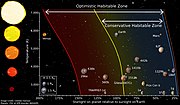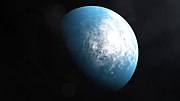In astronomy and astrobiology, the habitable zone (HZ), or more precisely the circumstellar habitable zone (CHZ), is the range of orbits around a star...
134 KB (13,731 words) - 01:21, 25 August 2024
Galactic habitable zone Goldilocks principle Habitable zone - Habitable zone for complex life Habitability of binary star systems Habitability of orange...
57 KB (3,077 words) - 06:48, 25 October 2024
the galactic habitable zone is the region of a galaxy in which life is most likely to develop. The concept of a galactic habitable zone analyzes various...
25 KB (3,156 words) - 14:08, 12 August 2024
atmosphere and geology. Of the natural satellites in the Solar System's habitable zone – the Moon, two Martian satellites (though some estimates put those...
37 KB (3,721 words) - 18:03, 19 October 2024
A Habitable Zone for Complex Life (HZCL) is a range of distances from a star suitable for complex aerobic life. Different types of limitations preventing...
48 KB (5,290 words) - 14:03, 3 September 2024
Environments do not need to contain life to be considered habitable nor are accepted habitable zones (HZ) the only areas in which life might arise. As the...
111 KB (13,145 words) - 11:49, 30 October 2024
habitable zone Habitability of F-type main-sequence star systems Habitability of neutron star systems Habitability of red dwarf systems Habitability of...
10 KB (972 words) - 23:47, 27 October 2024
the only ones in which the habitable zone coincides completely with the ultraviolet habitable zone. Since the habitable zone is farther away in more massive...
35 KB (3,485 words) - 23:02, 3 May 2024
indeterminate reasons. On the other hand, 3D climate models favor habitability and wider habitable zones for slow rotating and tidally locked planets. A major impediment...
46 KB (5,548 words) - 12:39, 4 October 2024
Kepler-452b (category Super-Earths in the habitable zone)
01) is a super-Earth exoplanet orbiting within the inner edge of the habitable zone of the sun-like star Kepler-452 and is the only planet in the system...
21 KB (1,899 words) - 00:55, 30 October 2024
PSR B1257+12 are close to the habitable zone and as of 2015, no known pulsar planet is likely to be habitable. A habitable planet orbiting a neutron star...
5 KB (575 words) - 03:55, 31 October 2024
F9.5 concluded that exoplanets/moons around exoplanets orbiting in habitable zones of F-type stars would receive excessive UV damage as compared to the...
13 KB (1,472 words) - 12:53, 21 September 2024
Circumstellar habitable zone Habitability of yellow dwarf systems Planetary habitability Circumbinary planet "Earth-Sized 'Tatooine' Planets Could Be Habitable" (Press...
9 KB (1,080 words) - 23:21, 8 September 2024
Exoplanet (redirect from Habitability of exoplanets)
the habitable zone. Assuming there are 200 billion stars in the Milky Way, it can be hypothesized that there are 11 billion potentially habitable Earth-sized...
148 KB (15,970 words) - 14:48, 26 October 2024
Kepler-186f (category Exoplanets in the habitable zone)
designation KOI-571.05) is an Earth-sized exoplanet orbiting within the habitable zone of the red dwarf star Kepler-186, the outermost of five such planets...
32 KB (3,103 words) - 16:34, 1 November 2024
K2-18b (category Super-Earths in the habitable zone)
6 times the radius of Earth, with a 33-day orbit within the star's habitable zone. This means it receives about a similar amount of starlight as the Earth...
43 KB (4,997 words) - 19:12, 3 November 2024
TOI-700 d (category Near-Earth-sized exoplanets in the habitable zone)
is a near-Earth-sized exoplanet, likely rocky, orbiting within the habitable zone of the red dwarf TOI-700, the outermost planet within the system. It...
11 KB (934 words) - 15:17, 8 September 2024
Gliese 581c (section Habitability and climate)
upon the planet's habitability. Based on newer models of the habitable zone, the planet is likely too hot to be potentially habitable. In astronomical...
38 KB (3,766 words) - 05:32, 16 August 2024
only current example of a habitable planet. At a distance of 1 AU from the Sun, it is within the circumstellar habitable zone of the Solar system, which...
53 KB (6,002 words) - 10:32, 3 November 2024
TOI-715 b (category Super-Earths in the habitable zone)
TOI-715 b is a super-Earth exoplanet in the habitable zone of its parent M-type star, TOI-715. The planet is 1.55 times larger than Earth, and is located...
7 KB (621 words) - 17:00, 25 October 2024
Wolf 1069 b (category Near-Earth-sized exoplanets in the habitable zone)
star Wolf 1069. Being located in the habitable zone of its star, Wolf 1069 b is considered a potentially habitable planet, as well as the sixth-closest...
7 KB (730 words) - 16:56, 19 July 2024
Kepler-22b (category Exoplanets in the habitable zone)
Interest designation KOI-087.01) is an exoplanet orbiting within the habitable zone of the Sun-like star Kepler-22. It is located about 640 light-years...
19 KB (1,838 words) - 01:31, 23 October 2024
will be optimized to search for and image Earth-size habitable exoplanets in the habitable zones of their stars, where liquid water can exist, by using...
7 KB (634 words) - 01:33, 20 October 2024
LHS 1140 b (category Super-Earths in the habitable zone)
LHS 1140 b is an exoplanet orbiting within the conservative habitable zone of the red dwarf LHS 1140. Discovered in 2017 by the MEarth Project, LHS 1140...
15 KB (1,630 words) - 02:49, 29 September 2024
Kepler-62f (category Super-Earths in the habitable zone)
designation KOI-701.04) is a super-Earth exoplanet orbiting within the habitable zone of the star Kepler-62, the outermost of five such planets discovered...
24 KB (2,434 words) - 03:25, 11 September 2024
The atmosphere is right, and there are real monsters." Because the zone habitable by humans is 'relatively narrow' (5% closer in and farther out than...
7 KB (976 words) - 10:20, 28 October 2024
Super-Earth (section First in habitable zone)
super-Earths within the Gliese 581 planetary system, both on the edge of the habitable zone around the star where liquid water may be possible on the surface. With...
63 KB (7,365 words) - 23:27, 18 October 2024
TRAPPIST-1e (category Near-Earth-sized exoplanets in the habitable zone)
J23062928-0502285 e, is a rocky, close-to-Earth-sized exoplanet orbiting within the habitable zone around the ultracool dwarf star TRAPPIST-1, located 40.7 light-years...
30 KB (2,722 words) - 13:03, 29 October 2024
Gliese 667 Cc (category Super-Earths in the habitable zone)
Cc, HR 6426 Cc, or HD 156384 Cc) is an exoplanet orbiting within the habitable zone of the red dwarf star Gliese 667 C, which is a member of the Gliese...
14 KB (1,639 words) - 22:04, 18 August 2024
Circumstellar habitable zone Earth analog Extraterrestrial liquid water Galactic habitable zone Habitability of binary star systems Habitability of natural...
15 KB (1,472 words) - 16:20, 28 October 2024





















